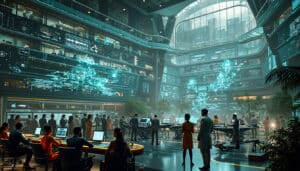« `html
The streets of our cities are taking a decidedly futuristic turn. Legendary robotic figures, such as the iconic Robocop, are beginning to patrol, providing a sense of technological security. This shift, long considered pure science fiction, is becoming our reality before our eyes.
The introduction of robotic patrols equipped with advanced artificial intelligence is reshaping urban landscapes. These machines, adorned with a suite of sophisticated sensors and cameras, monitor public spaces with a vigilance that complements human efforts. While they don’t replace human officers, their presence significantly reduces repetitive tasks and enhances overall security. Citizens are gradually acclimating to these towering figures, whose constant watchfulness sparks both fascination and debate.
Thailand has taken a monumental step in this technological evolution by unveiling the Cyborg 1.0, the nation’s first autonomous police robot. This robotic law enforcement officer boasts a 360-degree vision system and the capability to perform facial recognition, revolutionizing urban surveillance. As Cyborg 1.0 navigates the streets, its ability to detect and respond to threats autonomously raises critical questions about the balance between public safety and privacy.
The deployment of robotic policemen like Cyborg 1.0 enhances the efficiency of law enforcement agencies by providing an additional layer of oversight. These robots can intervene in situations where immediate response is necessary, ensuring a swift and effective reaction to potential dangers. However, their integration into daily life prompts intense discussions about the ethical implications and the potential erosion of civil liberties.
Looking ahead, the rapid advancement of robotics suggests that similar innovations will soon permeate other sectors of society. Companies are already planning projects to extend the use of robots beyond policing, envisioning a future where machines are integral to various aspects of our routines. This trend is gradually transforming our perception of robots from mere machines to essential partners in maintaining the security and functionality of our urban environments.

« `html
Welcome to the future, where Robocop has traded his sci-fi origins for real-world streets, patrolling our cities with a blend of high-tech sophistication and mechanical charm. Imagine walking down your local boulevard and spotting a towering figure equipped with advanced artificial intelligence and a suite of sophisticated sensors keeping an eye on everything from suspicious activities to stray pigeons. This isn’t a scene from a blockbuster movie—it’s our new reality. These robotic patrols are designed to enhance public safety without replacing human officers, striking a balance between technology and the human touch that’s essential for community policing.
The integration of robotic law enforcement units like Robocop brings a sense of security that’s both comforting and unnerving. On one hand, citizens can feel safer knowing that these machines are tirelessly monitoring public spaces with precision and consistency. On the other hand, the presence of such formidable figures raises questions about privacy and the ethical implications of surveillance carried out by non-human entities. Nevertheless, the promise of reducing repetitive tasks for human officers means that police can focus more on complex and nuanced aspects of law enforcement, potentially leading to a more effective and responsive police force.
Robocop’s patrols are not just about maintaining order; they’re about redefining urban security. With 360-degree vision and the ability to process data from multiple camera feeds and sensor inputs in real-time, these cyborgs can respond to incidents faster and more accurately than ever before. The technology behind Robocop is a marvel of modern engineering, combining machine learning with human-like decision-making processes to navigate the complexities of urban environments. As these robots become more prevalent, they may reshape how we perceive safety and the role of technology in our daily lives.
Table of contents
Togglehow does robocop enhance urban security?
Robocop brings a new dimension to urban security by leveraging cutting-edge technology to monitor and respond to incidents with unprecedented efficiency. Equipped with an array of advanced sensors and AI-driven analytics, Robocop can detect unusual activities, analyze patterns, and predict potential threats before they escalate. This proactive approach allows for quicker intervention, potentially preventing crimes from occurring in the first place. Additionally, Robocop operates tirelessly, ensuring that public spaces are under constant surveillance without the limitations of human fatigue or distraction.
One of the key advantages of Robocop is his ability to integrate seamlessly with existing law enforcement systems. By connecting to databases and communication networks, Robocop can access real-time information, coordinate with human officers, and provide instant updates on ongoing situations. This interconnectivity enhances the overall efficiency of the police force, ensuring that resources are allocated where they are needed most. Furthermore, Robocop’s presence alone can act as a deterrent to potential criminals, knowing that any illicit activity is being closely monitored by an intelligent and responsive system.
Beyond crime prevention, Robocop can assist in managing crowd control during large events, natural disasters, or emergencies. His ability to navigate through dense crowds, identify hazards, and provide vital information can be invaluable in ensuring public safety. By handling these tasks, Robocop allows human officers to focus on more complex and sensitive aspects of crowd management, such as addressing individual concerns and providing emotional support to those in distress. This collaborative effort between humans and robots can lead to a more harmonious and secure urban environment.
what technology powers robocop’s patrols?
At the heart of Robocop’s impressive capabilities lies a suite of state-of-the-art technologies that work in harmony to create a highly effective robotic law enforcement unit. Central to this is his artificial intelligence, which enables Robocop to process vast amounts of data in real-time, making informed decisions based on pattern recognition and predictive analytics. This AI is continually learning and adapting, allowing Robocop to improve his performance and respond more intelligently to evolving threats and changing urban dynamics.
Robocop is also equipped with a comprehensive array of sensors and cameras that provide him with a 360-degree view of his surroundings. These sensory inputs allow him to monitor environmental conditions, detect movement, and recognize faces with high accuracy. The integration of machine learning algorithms means that Robocop can analyze this data to identify suspicious behavior, track individuals across multiple locations, and even predict where incidents might occur based on historical data and real-time inputs.
Communication is another critical aspect of Robocop’s technology. He is connected to centralized databases and network systems, enabling instant access to information such as criminal records, no-fly lists, and emergency protocols. This connectivity allows Robocop to coordinate seamlessly with human officers, share vital information, and provide real-time updates during operations. Additionally, Robocop’s mobility systems ensure that he can navigate urban environments with ease, whether it’s maneuvering through narrow alleyways or navigating busy intersections, all while maintaining operational efficiency and effectiveness.
how are citizens reacting to robocop’s presence?
The introduction of Robocop into city streets has sparked a wide range of reactions among citizens, blending excitement with apprehension. Many people are fascinated by the advanced technology and the potential benefits it brings to public safety. The idea of having a highly efficient, tireless protector patrolling the streets is appealing, especially in areas where crime rates have been a concern. The visible presence of Robocop can provide a sense of reassurance, knowing that there is an additional layer of security watching over the community.
However, not all reactions are positive. Some citizens express concerns about privacy and the implications of widespread surveillance conducted by robotic units. The constant monitoring and data collection capabilities of Robocop raise questions about the extent to which personal lives are being observed and recorded. There is also apprehension about the potential for malfunctions or misuse of the technology, which could lead to unintended consequences or abuses of power. These concerns highlight the need for clear regulations and transparent policies to ensure that the deployment of Robocop respects individual rights and maintains public trust.
Community engagement is crucial in addressing these mixed reactions. Town hall meetings, public forums, and informational campaigns can help educate citizens about the benefits and limitations of robotic law enforcement. By fostering open dialogue, authorities can address fears, dispel myths, and demonstrate how Robocop complements rather than replaces human officers. Building a collaborative relationship between the community and law enforcement ensures that the integration of Robocop is met with understanding and support, ultimately leading to a more harmonious coexistence between humans and their robotic protectors.
what are the ethical implications of robotic policing?
The deployment of Robocop and similar robotic units into law enforcement roles brings forth a host of ethical considerations that society must grapple with. One of the foremost concerns is the potential for bias in artificial intelligence systems. If Robocop’s algorithms are trained on biased data, there is a risk that his decision-making processes could perpetuate or even exacerbate existing inequalities within the justice system. Ensuring that the AI governing Robocop is fair, unbiased, and transparent is paramount to maintaining equity and justice in law enforcement.
Another significant ethical issue revolves around accountability. In instances where Robocop makes a mistake or causes unintended harm, determining responsibility can be complex. Is it the fault of the manufacturer, the software developers, or the law enforcement agency that deployed him? Establishing clear lines of accountability is essential to address potential issues and ensure that victims receive appropriate redress. Moreover, there is the concern of autonomy—to what extent should robots be allowed to make critical decisions without human oversight? Striking a balance between automation and human control is necessary to mitigate risks and uphold ethical standards.
Privacy is another area of ethical concern. The extensive surveillance capabilities of Robocop mean that vast amounts of personal data are being collected and processed. Safeguarding this data against misuse, ensuring compliance with privacy laws, and establishing strict data governance practices are vital to protect individual freedoms. Additionally, the presence of robotic patrols can alter the social dynamics of urban spaces, potentially creating an environment of constant monitoring that affects how people interact and behave. Addressing these ethical implications requires thoughtful legislation, ongoing oversight, and a commitment to preserving the fundamental rights of all citizens.
what does the future hold for robotic law enforcement?
As technology continues to advance at a breakneck pace, the future of robotic law enforcement like Robocop looks promising yet complex. Innovations in artificial intelligence, machine learning, and robotics are poised to make these machines even more capable and autonomous. Future iterations of Robocop could feature enhanced cognitive abilities, enabling them to understand and interpret human emotions, making them more effective in de-escalating tense situations and interacting with the public in a more humane manner.
Moreover, the integration of augmented reality and virtual reality could provide Robocop with advanced navigational tools and simulation training, allowing him to prepare for and respond to a wider array of scenarios with greater precision. The development of self-healing materials and improved battery technologies could extend Robocop’s operational lifespan and functionality, making him a more resilient and reliable component of urban security systems.
However, the future also brings challenges that must be addressed to ensure the responsible deployment of robotic law enforcement. Issues such as ethical governance, public trust, and legal frameworks will play crucial roles in shaping how these technologies are integrated into society. Collaborative efforts between technologists, policymakers, and communities will be essential to navigate the complexities and maximize the benefits of robotic law enforcement while minimizing potential drawbacks.
Looking further ahead, the expansion of robotic policing could lead to specialized units equipped to handle specific tasks, such as cybersecurity threats, disaster response, or public health emergencies. These specialized robots would work alongside human officers, providing expertise and capabilities beyond human limitations. The ongoing evolution of Robocop and similar units will likely transform the landscape of law enforcement, offering new tools and strategies to maintain safety and order in an increasingly complex and technologically driven world.









